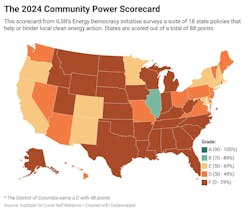Self-Reliance Scorecard Lauds State Legislation Helping DERs and Microgrids Overcome Utility Barriers to Local Energy
In many states, legislation – or lack of it – gives utilities control over issues that affect the development of local energy, including microgrids and distributed energy resources (DER).
A new state scorecard from the Institute for Local Self-Reliance (ILSR) focuses on the need for state legislation that levels the playing field for DERs and microgrids, allowing them to compete and increase the development of local energy sources.
Only one state – Illinois – garnered an above average grade, 11 states earned C averages, 13 received Ds and 26 received F grades, according to the 2024 Community Power Scorecard.
Utility customers seek choices
Maria McCoy, researcher for ILSR and author of the report, said that when it comes to energy, people want to be able to choose what works best for them – whether it’s community solar, community choice aggregation or power purchase agreements (PPA) for solar and storage. Often, legislation is needed to ensure that utilities don’t stand in the way of achieving that goal.
“We are trying to use our community power scorecard to make it more about how much clean energy is available and the ability of people to make their own decisions,” she said.
The scorecard ranks states based on policies about interconnection, net metering, utilities sharing hosting capacity information, community solar, on-bill financing of solar and storage purchases, and other issues.
State policies should speed interconnection, report says
Interconnection policies are important to microgrid and DER development, and interconnection hassles can undermine development. The International Energy Agency estimates that more than 3,000 GW of projects are stalled in interconnection queues globally, slowing microgrid and DER deployment and the clean energy transition.
“A model interconnection policy in 2024 allows small projects to move quickly through the interconnection process, has a nuanced understanding of energy storage and intentionally increases grid access for low-income or underserved communities,” said the scorecard.
New Mexico is the only state that has a policy on equitable interconnection, according to the scorecard. Washington, D.C. and Illinois gained the highest scores from the scorecard for their interconnection policies, while Alabama, Alaska and Georgia were among the states that scored the lowest.
Net metering policies help get more renewables deployed
Also important to microgrid and DER development is net metering, which generally provides a solar- or wind-producing utility customer with credits when the customer sends excess energy to the grid. More and more utilities are trying to walk back net metering laws, saying that customers who don’t produce renewable energy subsidize the solar or wind producers.
“Utilities are talking about how solar is expensive for nonsolar customers. That’s a false narrative,” said McCoy. Especially in states that don’t yet produce much solar energy, such efforts to kill net metering crush the potential to deploy solar, she said.
State Experiences in Microgrid Planning
Think Microgrid State Scorecard
Both in Focus for Content Sessions at Microgrid Knowledge 2024
Happening April 22-24 in Baltimore: Register Now
It’s important that states enact net metering laws that support the development of solar and solar plus storage. The Interstate Renewable Energy Council offers some model net metering policies, said the report.
Illinois, Maine, Washington, D.C. and Connecticut were among the states that received high grades for net metering, while Alabama and Georgia scored Fs on net metering.
Power purchase agreements important to local energy
The scorecard also ranked states on legislation that allows for third-party ownership of projects.
“States have to allow third-party ownership,” said McCoy. “Without some kind of clarity about whether you can buy power from someone who isn’t a utility, it can be onerous or impossible to set up those contracts.” It’s important to implement state legislation that allows for customers to sign PPAs with nonutilities, she said. California, Georgia, Iowa and Maine were among the states that received high marks for their third-party ownership policies.
Few states offer updated hosting capacity maps
The scorecard takes a look at legislation requiring utilities to offer hosting capacity maps. DER developers have called for updated versions of these maps because they allow developers to see where hosting capacity is limited and where it might make the most sense to propose developments. While some utilities offer the maps, they often don’t reflect current conditions.
“Access to this information is another way to level the playing field for nonutility developers,” said McCoy. “Utilities want to keep this information to themselves and not facilitate interconnection of solar owned by other people.” In addition, keeping the maps updated requires utility time and resources, she said.
Most states didn’t receive good grades on this type of legislation.
Legislation should enable community solar, scorecard says
In addition, the scorecard looked at legislation enabling community solar. More and more, community solar is becoming important to microgrid developers. It can be included in a microgrid, and owning community solar can add value to a developer. For example, Scale Microgrids is interested in community solar because it can maximize the amount of solar that microgrid owners can use.
Only 19 states and Washington, D.C. have policies that require utilities to interconnect nonutility community solar projects, said McCoy.
“We want a competitive market that allows nonutilities to build community solar projects and provide savings, resilience and lower energy bills,” she said.
Some utilities, seeing that community solar is becoming popular with customers, are arguing that customers who don’t buy community solar are subsidizing those that subscribe to the projects.
On-bill financing for solar and storage
On-bill financing – or “inclusive utility investments” – is also addressed in the scorecard. With this type of program, the utility pays upfront for any cost-effective upgrades by customers and then gets its investment back through part of the savings customers receive on energy bills.
Right now, most utility on-bill financing programs only apply to the purchase of energy efficiency measures, said McCoy. ILSR would like to see this extended to the purchase of solar and storage.
“The model policy for inclusive utility investment is requiring that utilities offer it and not allowing consumer credit checks, as the cost recovery is tied to the meter rather than the customer,” said the scorecard. “Ideally, all cost-effective energy upgrades are covered, including rooftop solar.”
The legislative measures identified in the scorecard can go a long way toward increasing development of DERs, said McCoy. Such policies also help give utility customers more choice about their energy supply.
“People want to be able to choose what option is best for them,” said McCoy.
About the Author
Lisa Cohn
Contributing Editor
I focus on the West Coast and Midwest. Email me at [email protected]
I’ve been writing about energy for more than 20 years, and my stories have appeared in EnergyBiz, SNL Financial, Mother Earth News, Natural Home Magazine, Horizon Air Magazine, Oregon Business, Open Spaces, the Portland Tribune, The Oregonian, Renewable Energy World, Windpower Monthly and other publications. I’m also a former stringer for the Platts/McGraw-Hill energy publications. I began my career covering energy and environment for The Cape Cod Times, where Elisa Wood also was a reporter. I’ve received numerous writing awards from national, regional and local organizations, including Pacific Northwest Writers Association, Willamette Writers, Associated Oregon Industries, and the Voice of Youth Advocates. I first became interested in energy as a student at Wesleyan University, Middletown, Connecticut, where I helped design and build a solar house.
Twitter: @LisaECohn
Linkedin: LisaEllenCohn
Facebook: Energy Efficiency Markets


